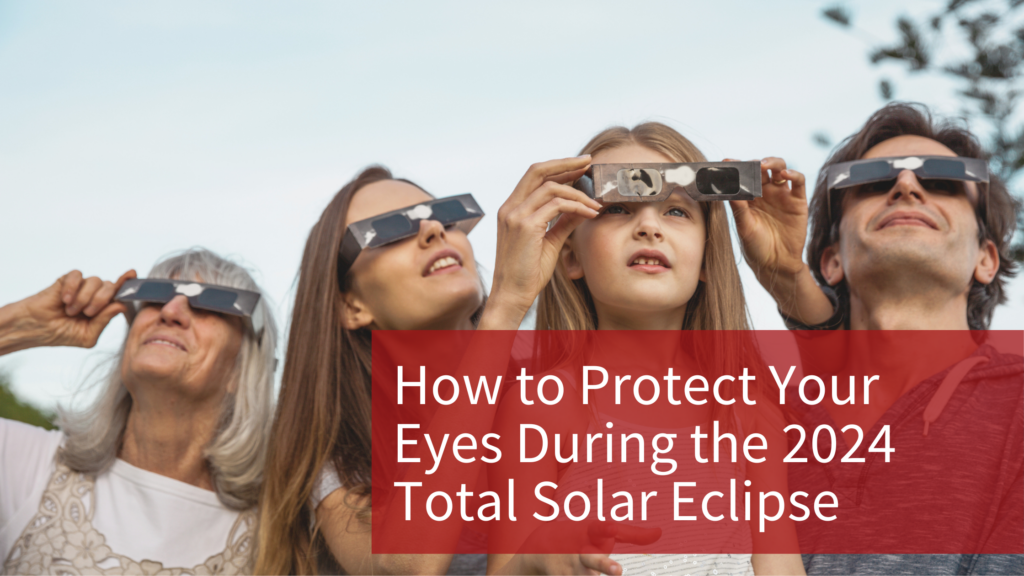On April 8, 2024, a total solar eclipse will cross North America, passing over Mexico, the United States, and Canada. A total solar eclipse happens when the Moon passes between the Sun and Earth, completely blocking the face of the Sun. The sky will darken as if it were dawn or dusk.
Witnessing a solar eclipse is a breathtaking experience, but we must prioritize the safety of our eyes. Without the right eye protection, the consequences of gazing at the eclipse can be severe. So, as we enjoy this awe-inspiring moment, let’s do so responsibly, ensuring that we’re equipped with the necessary gear to protect our eyes from harm.
Understanding the Solar Eclipse
A solar eclipse occurs when the moon obstructs part or all of the sun from our view. During a partial eclipse, the sun is gradually covered, creating a captivating celestial display that can last for hours. In the brief moments of a total eclipse, the sun is fully concealed, turning day into night. The solar corona, the sun’s outer atmosphere, emerges like a radiant halo around the moon, revealing bright stars and planets in the darkened sky.
The Risks of Direct Sun Staring
While the allure of the eclipse is undeniable, direct eye exposure to the sun poses serious risks. Even a momentary glance without proper eye protection can lead to permanent damage to the retina, a condition known as solar retinopathy, and, in extreme cases, blindness.
Next Total Solar Eclipse on the Horizon
According to NASA, after the April 8th, 2024 total solar eclipse, the next total solar eclipse that can be seen from the contiguous United States will be on August 23, 2044. As we eagerly anticipate this event, it’s crucial to prioritize eye safety for everyone involved.
Safeguarding Your Vision
The only safe way to gaze directly at the sun, whether during an eclipse or not, is through special-purpose solar filters. Eclipse glasses and handheld solar viewers equipped with filters meeting the ISO 12312-2 standard provide the necessary protection.
Ordinary sunglasses, even very dark ones, or homemade filters are not safe for looking at the sun.
5 Guidelines for Safe Solar Eclipse Viewing
- No Homemade Filters: Never use improvised or homemade filters when observing a solar eclipse. Only use approved solar viewing glasses or handheld solar viewers with ISO 12312-2 compliant filters to ensure adequate eye protection.
- Inspect Your Filters: Before use, carefully examine your solar filter or eclipse glasses. Any scratches or damages should be a red flag, indicating that the protection may be compromised.
- Follow Instructions: Read and adhere to the instructions accompanying your solar filter or glasses. It’s essential to ensure correct usage, especially when helping children with handheld solar viewers.
- Cover Before Looking: Stand still and cover your eyes with the solar filter or viewer before directing your gaze at the sun. Afterward, turn away and remove the filter—never remove it while looking at the sun.
- Avoid Optical Devices: Never use cameras, telescopes, binoculars, or similar devices without a proper solar filter. This caution extends to wearing eclipse glasses or holding a solar viewer simultaneously. The intense solar rays can damage both the filter and your eyes.
Where to Find Proper Eyewear
For information on obtaining the right eyewear or handheld viewers, consult the American Astronomical Society. They can guide you to reputable sources to ensure you’re equipped with the safest gear for this celestial spectacle.
While the allure of a solar eclipse is undeniable, safeguarding your eyes is non-negotiable. Embrace the wonder of the cosmos responsibly, and make the 2024 solar eclipse a truly unforgettable and safe experience for you and your loved ones.
